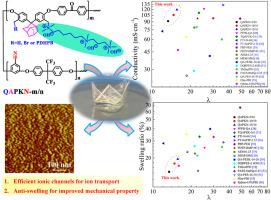Improved property of block copolymer-based anion exchange membranes by attaching multi-ion flexible strings
IF 8.1
2区 工程技术
Q1 CHEMISTRY, PHYSICAL
引用次数: 0
Abstract
To meet high conductivity and sufficient anti-swelling of anion exchange membranes (AEMs), a collaborative strategy of combining multi-ion flexible string and block backbone is adopted to construct membrane’s architecture. Then a series of adamantane-contained poly(arylether ketone nitrile)s block copolymers has been synthesized and grafted with multi-ion flexible strings to form hydrophilic domains. In addition, the hydrophobic segments with nitrile groups are aimed to enhance the entanglement between chains and limit swelling degrees of membranes. Along the steps, clear phase separation morphologies are formed for creating efficient ionic channels. The resulted AEMs exhibit improved conductivity and dimensional stability at low hydration levels, e.g. conductivity of 91.7–119.4 mS cm−1, swelling ratio (SR) of 14.4%–19.5%, water uptake (WU) of 38.3%–57.9% and λ values of 13.4–15.7 at 80 °C. Furthermore, the AEMs prepared exhibit excellent mechanical properties and good thermal stability below 180 °C. However, further optimization is required for a better alkaline stability.

通过连接多离子柔性串,改善嵌段共聚物阴离子交换膜的性能
为了满足阴离子交换膜(AEM)的高导电性和足够的抗膨胀性,采用了多离子柔性串与嵌段骨架相结合的合作策略来构建膜的结构。然后合成了一系列含金刚烷的聚(芳基醚酮腈)嵌段共聚物,并与多离子柔性串接枝形成亲水域。此外,带有腈基的疏水段旨在增强链之间的缠结,限制膜的膨胀度。在这些步骤中,形成了清晰的相分离形态,从而建立了有效的离子通道。所制备的 AEM 在低水合水平下具有更高的电导率和尺寸稳定性,例如,在 80 °C 时,电导率为 91.7-119.4 mS cm-1,溶胀率 (SR) 为 14.4%-19.5%,吸水率 (WU) 为 38.3%-57.9%,λ 值为 13.4-15.7。此外,制备的 AEM 还具有优异的机械性能和低于 180 °C 的良好热稳定性。不过,为了获得更好的碱性稳定性,还需要进一步优化。
本文章由计算机程序翻译,如有差异,请以英文原文为准。
求助全文
约1分钟内获得全文
求助全文
来源期刊

International Journal of Hydrogen Energy
工程技术-环境科学
CiteScore
13.50
自引率
25.00%
发文量
3502
审稿时长
60 days
期刊介绍:
The objective of the International Journal of Hydrogen Energy is to facilitate the exchange of new ideas, technological advancements, and research findings in the field of Hydrogen Energy among scientists and engineers worldwide. This journal showcases original research, both analytical and experimental, covering various aspects of Hydrogen Energy. These include production, storage, transmission, utilization, enabling technologies, environmental impact, economic considerations, and global perspectives on hydrogen and its carriers such as NH3, CH4, alcohols, etc.
The utilization aspect encompasses various methods such as thermochemical (combustion), photochemical, electrochemical (fuel cells), and nuclear conversion of hydrogen, hydrogen isotopes, and hydrogen carriers into thermal, mechanical, and electrical energies. The applications of these energies can be found in transportation (including aerospace), industrial, commercial, and residential sectors.
 求助内容:
求助内容: 应助结果提醒方式:
应助结果提醒方式:


